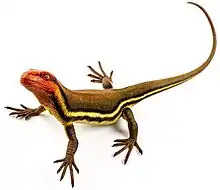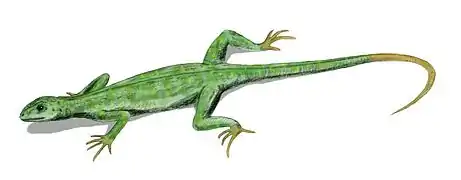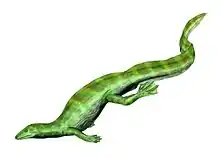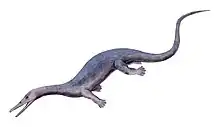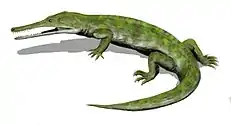Hescheleria
Hescheleria is an extinct genus of thalattosaurian marine reptile from the Middle Triassic (247.2 to ~235 Ma) of Monte San Giorgio in Switzerland. It is represented by a single type species, H. rubeli, which was named in 1936.[1]
| Hescheleria Temporal range: Middle Triassic | |
|---|---|
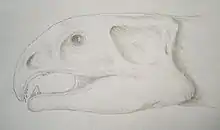 | |
| Recontruction of the head of Hescheleria | |
| Scientific classification | |
| Kingdom: | Animalia |
| Phylum: | Chordata |
| Class: | Reptilia |
| Order: | †Thalattosauria |
| Family: | †Thalattosauridae |
| Clade: | †Claraziidae |
| Genus: | †Hescheleria Peyer, 1936 |
| Type species | |
| Hescheleria rubeli Peyer, 1936b | |
Description
Like other thalattosaurs, Hescheleria has a slender lizard-like body with a long paddle-shaped tail. It is estimated to have grown to approximately 1 meter in length.
The skull possesses an unusually-shaped snout, with sharply downturned premaxillae. This forms a toothy hook at almost a right angle to the rest of the jaw, with a large diastema. The mandible is considerably robust and is dotted with small sharp teeth, along with a pair of pointed conical projections towards the tip, the function of which is unknown.[2] The strange skull suggests a highly specialized lifestyle. It has been speculated[1] that the projections on the mandible were used to crush hard-shelled prey such as molluscs. Other paleontologists disagree with this hypothesis,[2] arguing that the projections do not occlude against any other potential crushing surface in the jaws, instead making contact with the rostral diastema.
References
- Peyer, B. (1936b). "Die Triasfauna der Tessiner Kalkalpen. XI. Hescheleria ruebeli nov. gen. nov. sp". Schweizerische Paläontologische Abhandlungen. 58: 1–48.
- Rieppel, O.; Müller, J.; Liu, J. (2005). "Rostral structure in Thalattosauria (Reptilia, Diapsida)". Canadian Journal of Earth Sciences. 42 (12): 2081–2086. Bibcode:2005CaJES..42.2081R. doi:10.1139/e05-076.

